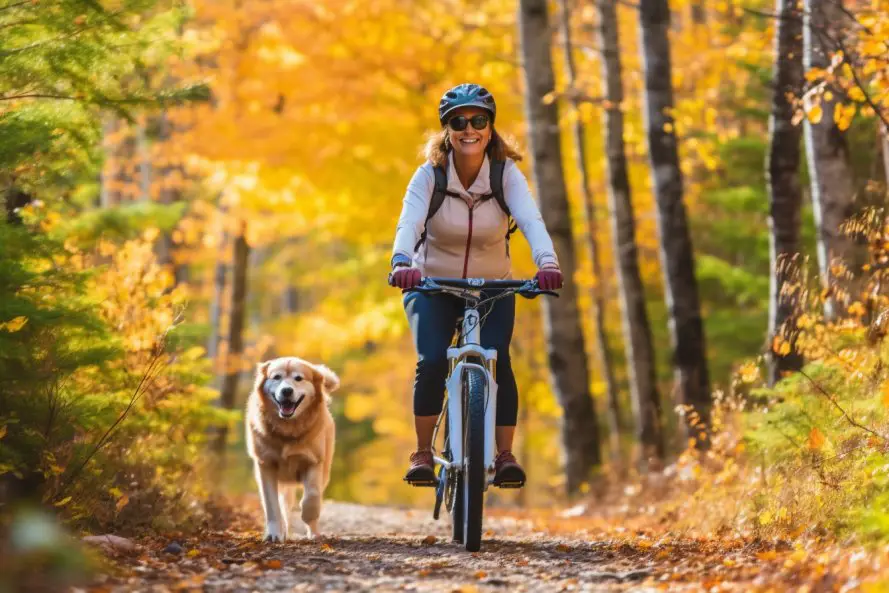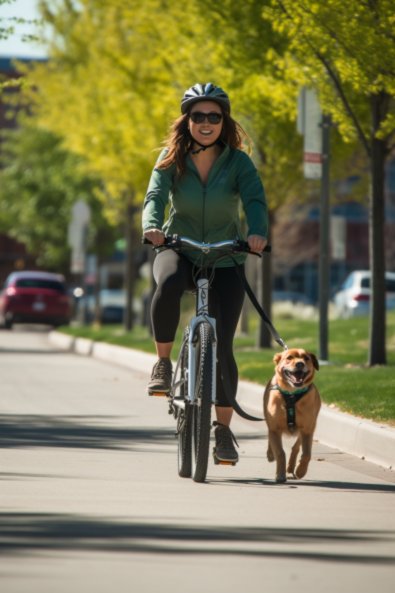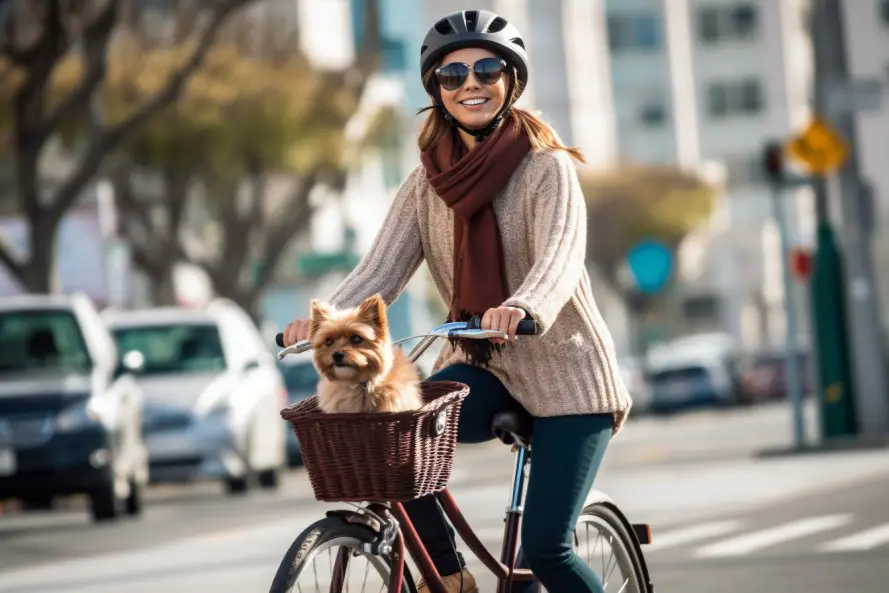Biking with Dog: Tips and Safety Guidelines

Biking with your furry friend can be an exhilarating experience that strengthens the bond between you and your canine companion. Engaging in this fun outdoor activity encourages a healthy lifestyle and offers mental stimulation for both you and your dog. This article will provide useful tips and insights on how to enjoy a safe and enjoyable ride with your beloved pet, ensuring a positive experience for both of you.
Before embarking on your biking adventures, it’s crucial to assess your dog’s fitness level, temperament, and breed characteristics. Some dogs might be more suited to long-distance cycling, while others may prefer shorter rides. Regardless of their stamina, safety should always be the top priority. Taking the time to select the appropriate gear and training techniques will ensure that you and your four-legged friend have a successful and enjoyable ride.
In the following sections, we will discuss essential cycling gear for both you and your dog, as well as effective training methods to help your dog adapt to biking environments. With proper preparation and sound advice, you can transform your ordinary bike rides into extraordinary adventures shared with your best friend.
Preparation and Safety
Consulting a Veterinarian
Before starting a bike ride with your dog, it is essential to consult with a veterinarian to ensure their health and safety. A veterinarian can assess your dog’s overall health and identify any potential health issues that might prevent them from safely participating in the activity. Some factors to consider include age, musculoskeletal development, and any pre-existing conditions.
Checking Your Dog’s Fitness
It is essential to ensure that your dog can handle the physical demands of biking. Overweight dogs or senior dogs may have difficulties keeping up, while puppies might not have fully developed musculoskeletal systems yet. Before your first ride, take your dog for a few walks and gradually increase the intensity to help build their fitness level. Monitor your dog for signs of fatigue, difficulty breathing, or discomfort during exercise.
Choosing the Right Equipment
Proper equipment is crucial for both your safety and your dog’s. Some options include:
- Leash and collar: A non-retractable, sturdy leash and a comfortable, well-fitting collar are essential.
- Bike attachment: Devices like bike tow leashes or walky dogs attach your dog’s collar or harness directly to the bike, keeping them at a safe distance and providing more control while biking.
- Harness: A well-fitting body harness can provide additional safety and comfort, distributing pressure evenly across your dog’s body.
- High-visibility gear: Reflective gear, such as vests or collars, is helpful for keeping your dog visible in low light conditions.
Understanding Your Dog’s Breed and Size
Different breeds and sizes of dogs have various capabilities, preferences, and health concerns. For example, some small dog breeds may not be able to keep up with a bike, and certain large dog breeds may be more prone to hip dysplasia or other joint issues. Research your dog’s breed to understand their unique needs and potential risks, and consult your veterinarian to determine the best biking plan for your dog.
Biking Equipment for Dogs
Harness and Leash Options
When biking with your dog, it’s essential to invest in a high-quality harness and leash option. A dog harness not only provides better control, but also distributes force more evenly across your dog’s body instead of their neck. Some popular types to consider:
- Body harness: These wrap around your dog’s torso allowing for minimal pressure on the neck and throat.
- Dog biking gear: Specialized dog bike leashes such as the Walky Dog and the Springer keep your dog at a safe distance from the bike.
To ensure a comfortable and secure fit, measure your dog’s chest and neck size before purchasing a harness.
| Type | Pros | Cons |
|---|---|---|
| Body Harness | Distributes force evenly, minimal pressure | Not specifically made for biking |
| Dog Biking Gear | Designed for biking, keeps a safe distance | Can be more expensive |
Trailers and Baskets
For smaller dogs or those who cannot run alongside your bike, consider trailers and baskets. These carriers attach to your bike, providing a secure space for your dog to ride.
- Trailers: Larger enclosed carriers with wheels, often suitable for dogs up to 75 pounds.
- Baskets: Smaller open carriers attached to your bike’s handlebars or rear, suitable for dogs up to 20 pounds.
Always ensure your dog is securely fastened within the carrier and keep an eye out for any signs of discomfort. Remember, not all dogs may be comfortable riding in a carrier.
Visibility and Safety Features
Safety should always be a top priority when biking with your dog. Implementing the following safety features will enhance visibility and protection:
- Reflective gear: Use reflective harnesses, leashes, and collars to increase visibility during low-light conditions.
- Lights: Attach lights to your dog’s harness, collar, or bike leash to increase nighttime visibility.
- Helmets: Consider a dog helmet to protect your pet’s head against potential accidents or obstacles.
By investing in the proper biking equipment, both you and your dog can safely enjoy the great outdoors together.

Training Your Dog to Bike
Introducing Your Dog to Biking
Start by walking your dog beside the bicycle, allowing them to become acquainted with the bike’s presence. Gradually increase the pace until you can jog beside the bike with your dog maintaining a steady speed. Keep these sessions short and gradually build up the distance and speed.
Teaching Cues and Commands
Train your dog to understand cues and commands specific to biking. Some essential commands include:
- “Slow”: to reduce speed
- “Stop”: to halt
- “Left” (or “haw”) and “Right” (or “gee”): to signal turns
Incorporating hand signals with your verbal commands can further reinforce these cues. Consistently practicing the commands will help your dog become more responsive and familiar with them.
Developing a Positive Association
To foster a positive association with biking, use treats and praise to reward your dog for good behavior. This will help them enjoy the experience and create a bond between the two of you during the activity.
- Promote a positive environment with verbal praise and affection
- Use treats to reinforce new commands and good behavior
- Take breaks to allow your dog to rest and maintain a positive mindset
Remember to be patient and understanding throughout the training process, as building a strong foundation will lead to a successful and enjoyable biking experience with your dog.
Biking Techniques and Tips
Maintaining Balance and Control
When biking with your dog, it’s essential to maintain balance and control. A bike leash is a helpful tool to connect your dog’s harness to your bike. While using a leash, maintain a firm grip on the handlebars and keep your eyes on the road. Ensure your dog is close enough to avoid tangling in the leash or veering off course. Practice biking with your dog in low-traffic areas first to build confidence.
Adjusting to Different Terrain
Before tackling different terrains, identify the ones you and your dog may encounter. This can include:
- Paved trails
- Gravel or dirt paths
- Hilly or sloped areas
Train your dog to adapt to these terrains, starting on smoother ground and slowly increasing the difficulty. Ensure they’re comfortable with the changes in surfaces and remain responsive to your commands when encountering these environments.
Taking Breaks and Warming Up
Just as humans need proper warm-ups and breaks, so does your dog. Before beginning your bike ride, set aside some time for a gentle warm-up. Walk your dog on a leash, allowing them to stretch and gradually increase the pace. Remember to:
- Monitor your dog’s behavior and energy levels
- Take regular breaks for hydration and rest
- Adjust the pace, duration, and intensity based on your dog’s abilities, age, and breed
By incorporating these biking techniques and tips, you and your dog will enjoy a safe and enjoyable biking experience.

Biking Activities With Dogs
Dog Running Alongside Bikes
One simple and enjoyable activity to do with your dog is to have them run alongside your bike. This type of exercise promotes healthy and active bonding between you and your pup. Ensure that you have a proper biking leash to keep your dog safely tethered during your rides.
- Start slow and assess your dog’s comfort level with running beside your bike.
- Gradually increase the duration and intensity of your rides.
- Pay close attention to your dog’s body language and fatigue levels.
Bikejoring
Bikejoring is an exciting biking adventure that involves your dog pulling you while you ride your bike. This sport requires a special harness for your dog and a towline attaching them to your bike.
- Train your dog to pull ahead and maintain a steady pace.
- Use verbal cues and commands to help your dog navigate turns and adjust speeds.
- Practice on various terrains and environments to improve your teamwork skills.
Hiking With Your Dog
Hiking with your dog offers the opportunity to explore beautiful trails and enjoy nature together. To make your hiking experience safe and enjoyable, keep the following tips in mind:
- Choose a suitable trail that accommodates both you and your dog’s fitness levels.
- Keep your dog on a leash to prevent them from disturbing wildlife or becoming lost.
- Bring water and dog-friendly snacks for your pet to keep them hydrated and energized during your hike.
Remember to always prioritize your dog’s safety and well-being during these biking activities. Monitor their behavior and condition, and don’t push them beyond their limits.
Age and Health Considerations
Biking With Puppies
When biking with puppies, it is important to take their age and physical capabilities into consideration. Puppies have different exercise needs and limits compared to adult dogs. It is generally recommended to wait until a puppy is at least 9-12 months old before introducing them to biking.
While biking, keep a close eye on their body language and signs of fatigue. Puppies need to gradually build up their endurance and should not be pushed too hard during the initial stages. Avoid long distance cycling as it may lead to joint stress and stunted growth. It’s essential to utilize a responsible recall system to ensure the puppy stays close to you. If biking on city streets, choose a location with minimal traffic to lessen distractions.
Exercising Senior Dogs
While senior dogs still need exercise, it’s essential to adapt the type and intensity to suit their aging bodies. Joint and muscle pain, arthritis, and cardiovascular decline are common issues to consider when biking with senior dogs. Depending on the individual dog, some may handle biking better than others, but generally, it is important to reduce the distance and pace appropriately. Instead of biking on uneven terrain, pick a flat location to avoid additional strain on their joints. Regular check-ups with your veterinarian are essential to assess your senior dog’s fitness for biking.
| Tips for Senior Dogs | |
|---|---|
| Distance | Shorter distances to accommodate reduced stamina and energy. |
| Pace | Slower pace to avoid excessive strain on joints and muscles. |
| Terrain | Opt for flat surfaces to minimize impact on their bodies. |
| Veterinary Check-ups | Regular visits to monitor their health and fitness levels. |
Caring for Physically Fit Dogs
For physically fit dogs, biking can be a fantastic activity to maintain their fitness levels and provide mental stimulation. It is crucial, however, to ensure your dog is genuinely fit and not pushed beyond their limits. Pay attention to signs of overexertion, fatigue, or discomfort. Consult with your veterinarian to determine the appropriate level of exercise for your dog’s age, breed, and health.
When biking with physically fit dogs, vary the terrain, routes, and distances. This helps keep them challenged and engaged. Training them to respond to recall commands can significantly contribute to a safe and positive biking experience. Regular hydration and rest breaks are essential to maintain their energy levels and prevent overheating.
Consider using safety gear such as:
- Reflective vests or collars for visibility.
- Dog booties to protect their paws, especially on hot or rough surfaces.
- A harness-style leash attachment to avoid pulling on their neck.
Conclusion
Biking with your dog can be a thrilling experience that fosters a strong bond and promotes a healthy lifestyle for both of you. To ensure a safe and enjoyable ride, consider your dog’s fitness level, temperament, and breed characteristics. Consult with a veterinarian to assess their health and select appropriate biking gear, including a sturdy leash, bike attachment, and high-visibility gear.
Proper training is essential for your dog’s comfort and safety during bike rides. Gradually introduce them to the bike and teach specific cues and commands. Create a positive association by using treats and praise. Implement biking techniques such as maintaining balance and control, adjusting to different terrains, and taking breaks for hydration and rest.
Remember to prioritize your dog’s age and health considerations. Adjust the activity to suit their capabilities and consult with a veterinarian as needed. By following these tips and guidelines, you and your furry friend can embark on exciting biking adventures, building a stronger bond and enjoying the outdoors together.






